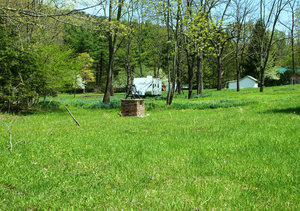Advertisement

 CLOVER LICK
CLOVER LICK
This bottomland on the east side of the Greenbrier River at Clover Lick. It seems likely that the farmers would want their fort on the east side of the river so if they were forced to retreat from Indians the river would be behind them. There is no trace of the fort there now.Day 18: May 9, 2013
Last night I was the only person in the whole Greenbrier Lodge. They only have 5 rooms there and the other 4 were vacant. When the restaurant closed all of the employees went home. It was kind of a strange way to spend a night. I had pancakes and ham downstairs in the restaurant before meeting the local historian, Bill McNeal, at the museum. He was a kind old gentleman and did his best to answer my inquiries about the location of the militia fort. The information we needed turned out to be in a book other than the one he found. Bill turned out to be one of our distant cousins through the Poage line.
Clover Lick John and Robert Poage waded onto the beach in Virginia bound from Ireland in about 1740. George Poage was Robert’s son. George was a frontiersman, Indian fighter, and farmer. All of the farmers were in the militia and George was their leader. He commanded an outpost for a period of time at a place called Clover Lick. It was in good bottomland along the Greenbrier

 WOODS POAGE CHURCH
WOODS POAGE CHURCH
This is the Woods Poage Chapel. It was built in 1919 by descendants of George Poage. River. It was the very edge of American settlement when he was there in 1767. He liked the area, but did not want to raise a family there. He raised his family further east on the James River, but two of his sons moved back to Clover Lick to raise their families. George was an army officer through many wars and campaigns and was commandant at Fort Dinwiddie before the Revolutionary War. During the Revolution he served in George Washington’s army. He was Justice of the Peace appointed by Thomas Jefferson, and he was commissioned to survey the road along the James River. That road started out to be an Indian trail, then it became a route for immigration into Ohio, and finally it was overbuilt by the railroad. Trains are still running on the road George surveyed. His family lived in the area of Clover Lick for over a century. Most of the local population in Pocahontas County are our cousins. The gene pool is pretty shallow there.
Bath County The Poage line and the Oliver line intersected in this little corner of Virginia. It is stunningly beautiful country still. A
fellow named Joseph Oliver was a pioneer settler in Bath County sometime around 1760. Joe took up a portion of the Lewis Grant along the Jackson River near Fort Dinwiddie. He did not hold that land very long before moving on to other ventures. Joe had two sons, John and William. John liked Bath County and was the big dog with the brass collar in the area of Warm Springs. John married Agness Frogg and they had no children. William was more like his dad, always on the lookout for something new to try. William left tracks that are harder to follow, but he raised a passel of kids. One of them was named John, after his uncle. John was conscripted into the army in February of 1815 at Warm Springs and marched off to fight the redcoats in the War of 1812. A month later they all marched back home and were discharged because the war was over with in 1814. John married Elizabeth Hill, who was George Poage’s granddaughter. John and Elizabeth are J.J.’s parents. In 1852 John and Elizabeth moved out to Scotland County, Missouri and settled onto a farm near Memphis.
I have

 FORT DINWIDDIE
FORT DINWIDDIE
This sign is all that is left of the Fort. It was built on the west side of the Jackson river less than a mile from Joseph's property.settled in for the evening at the Rose Loe motel in Hot Springs after drive of about 90 miles or so. Supper was at a place called the Country Café and was a pretty dang toothsome dish of chicken pasta primavera. Somebody in these backwoods has been watching the cooking channel I guess. When I checked into this motel a crew of roofers were hard at work putting down new shingles. I hope to be gone before it rains again because the roof on this building has no shingles. Other than that it seems like a pretty nice place to stay.
Advertisement
Tot: 0.068s; Tpl: 0.011s; cc: 12; qc: 30; dbt: 0.0274s; 1; m:domysql w:travelblog (10.17.0.13); sld: 1;
; mem: 1mb

 CLOVER LICK
CLOVER LICK
 WOODS POAGE CHURCH
WOODS POAGE CHURCH
 FORT DINWIDDIE
FORT DINWIDDIE


